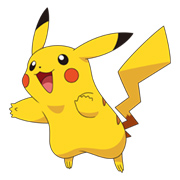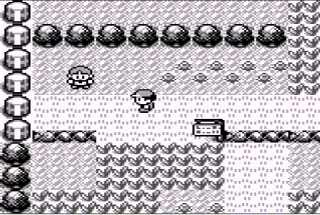Overview
Created by Game Freak and published by Nintendo, the Pokémon, or Pocket Monsters, series began on March 21,1996, with the original Japanese Game Boy release of Pokémon Red and Green, later released in North America as Pokémon Red and Blue. The main, role-playing installments of the franchise are typically released in pairs, with minor differences between the two iterations, meaning that 100% completion can only be achieved by linking to a friend with the game and swapping the missing creatures. Some entries in the series see a later third version, featuring additional alterations and improvements over the previous 2 versions.
Although the original game introduced 151 different species of Pokémon, later iterations have continued to add new species, bringing the current total to 898, with many species having additional regional variants or mega-evolved forms.
Sub-Franchises
Pokémon Stadium | Pokémon Mystery Dungeon | Pokémon Ranger | Pokémon Rumble | Pikachu | Pokémon Trozei | Pokédex | Pokémon TCG | Pokémon Pinball | Pokémon Snap |
Pokémon
See Pokémon (Concept) for list of all 898 Pokémon.
 Pikachu, the official mascot of Pokémon
Pikachu, the official mascot of PokémonPokémon are special creatures that appear throughout the Pokémon franchise. The player can use their own Pokémon to battle them, allowing them to capture the Pokémon for future use. There are currently 898 different Pokémon in the series, and not all can be captured in a single game. Players can use a Pokédex to keep track of all Pokémon seen and captured.
Each Pokémon has one or two types (out of a total of 18), and can learn up to 4 different moves at a time. Each Pokémon has a base stat point distribution, spread between 6 stats: Attack, Defense, Special Attack, Special Defense, Speed, and HP. Pokémon earn experience every time they make an opponent faint, and will increase their stats automatically every time they level up. From the third Generation onward, Pokémon also have a nature, which will increase or decrease certain stats, and an ability, which is a special attribute that might help (or hinder) it in battle. Players can affect their Pokémon stat point gain through Effort Value (EV) and Individual Value (IV) manipulation, which can boost a Pokémon's stat points significantly.
Many Pokémon can evolve, changing to a new form with slightly different abilities, upon meeting certain prerequisites, typically a set experience level. The Pokémon will retain its moves, nature, EVs, and IVs, but will gain (or sometimes lose) stat points. Some evolutions will also change the Pokémon's type or abilities, and gain access to new skills that might not have been available in their previous form. Some Pokémon have branching evolutions, where the Pokémon can evolve into a different Pokémon based on their evolution method.
Pokémon are captured using special capsule-like devices known as Poké Balls. These balls are bought, found, or sometimes made, and can only be used on wild Pokémon. There are many different types of balls, from the basic red-and-white Poké Ball to the Master Ball, a valuable ball which will capture any wild Pokémon without fail. Players can also trade their Pokémon, either through local connections, or via a global trading system first introduced with the series' fourth Generation.
Main Games
The main series of Pokémon titles is divided into different generations, roughly indicating a pair of releases. Each generation features a new region, with new Pokémon to catch and new places to explore. The main games and their spin-offs, the anime, the manga, and the trading card game are all updated with the new Pokémon properties each time a new generation begins.
First Generation (Kanto)
 Pokémon Red/Blue
Pokémon Red/BlueThe first games in the series were Pokémon Red/Blue (Red/Green in Japan), released September 1998 in America for the Game Boy. After the success of the first games and the animated series, Pokémon Yellow was released October 1999, with a plot inspired by the anime. These games started off the Pokémon craze around the world, and set many of the gameplay standards still seen in current games, such as Pokémon Types and the battle system.
Second Generation (Johto)
 Pokémon Crystal
Pokémon CrystalThe second Generation of Pokémon games began in 2000 with the release of Pokémon Gold/Silver for the Game Boy Color. Like the previous generation, an enhanced remake titled Pokémon Crystal was later released. The second generation introduced 100 new species of Pokémon (starting with Chikorita and ending with Celebi), for a total of 251 Pokémon to collect, train, and battle. The second generation was a particularly well acclaimed one, thanks to it's large amount of new features and it's overall appeal. This popularity led Nintendo to remake the games in 2010, as HeartGold/SoulSilver.
Third Generation (Hoenn)
 Pokémon Ruby/Sapphire
Pokémon Ruby/SapphireThe third Generation began with the 2003 release of Pokémon Ruby/Sapphire for the Game Boy Advance and continued with the Game Boy Advance remakes of Pokémon Red/Blue, Pokémon FireRed/LeafGreen, and an enhanced version of Pokémon Ruby/Sapphire: Pokémon Emerald. The third generation introduced 135 new Pokémon (starting with Treecko and ending with Deoxys) for a new total of 386 species. However, this generation also garnered some criticism for leaving out several gameplay features, including the day-and-night system introduced in the previous generation, and it was also the first installment that encouraged the player to collect merely a selected assortment of the total number of Pokémon rather than every existing species (202 out of 386 species are catchable in the Ruby and Sapphire versions).
On May 7th, 2014, Nintendo announced remakes of Ruby/Sapphire, titled Omega Ruby/Alpha Sapphire, released on November 21, 2014.
Fourth Generation (Sinnoh)
 Pokémon Diamond/Pearl
Pokémon Diamond/PearlIn 2007, the franchise entered its fourth Generation with the release of Pokémon Diamond/Pearl for the Nintendo DS. The fourth generation introduced another 107 new species of Pokémon (starting with Turtwig and ending with Arceus), bringing the total of Pokémon species to 493. New gameplay concepts include a restructured move-classification system, online multiplayer trading and battling via Nintendo Wi-Fi Connection, the return (and expansion) of the second generation's day-and-night system, and the expansion of the third generation's Pokémon Contests into Super Contests. The new region of Sinnoh also has an underground component for multiplayer gameplay in addition to the main overworld. Pokémon Platinum - the enhanced version of Diamond/Pearl much like Yellow, Crystal and Emerald - was later released to western countries in 2009.
Later on March 14, 2010, Pokemon HeartGold/SoulSilver was released, a remake of the Johto adventures Gold/Silver/Crystal. It implements many features from Diamond/Pearl/Platinum, such as the Global Trading Station (GTS), due to the use of the same engine. It also introduced a mechanic where a trainer's current Pokémon appears behind them in the world, a popular concept not typically present in later entires.
In 2021, Nintendo announced remade versions of Diamond/Pearl, under the name Brilliant Diamond/Shining Pearl, developed by ILCA rather than Game Freak.
Fifth Generation (Unova)
 Pokémon Black/White
Pokémon Black/WhiteThe fifth Generation of games was first announced in 2010, with Pokemon Black/White for the Nintendo DS, which arrived in America on March 6, 2011. This generation added another 156 Pokémon to the series, and featured more dynamic camera angles and fully animated Pokémon sprites, last seen in Crystal.
Black/White were the series' first entries to not use older Pokémon within the main story arc, with pre-fifth generation species only appearing after the Elite Four have been beaten. It also introduced the Pokémon Global Link, the successor to the GTS, and allowed access to the Dream World, a website which allowed players to find Pokémon with special abilities not usually found in game.
In October 7, 2012, a direct sequel to Black/White, Black/White Version 2, was released, again for the DS. It marks the first time a Pokémon game received a direct sequel set in the same region, being set 2 years after the first games. Many of the older characters return in this game, but the player plays a new character starting out in a new town. All the features of Black/White returned, with no major changes to the formula.
Sixth Generation (Kalos)
 Pokémon X/Y
Pokémon X/YThe sixth Generation of games was announced on January 8, 2013 during a Pokémon Direct press event, the first of its kind. Pokémon X/Y for the Nintendo 3DS were the main Pokémon games to see a simultaneous worldwide release, which took place on October 12th 2013. These games introduced 70 new Pokémon, a fully 3D world, the Fairy type, Mega Evolutions, a lower camera angle, and a new battle system, combining the series' traditional battle system with the mechanics of the Stadium games.
Other Official Media
Anime
 The title screen for season 13: Sinnoh League Victors
The title screen for season 13: Sinnoh League VictorsThe Pokémon anime series began in 1997 and now has spread all across the world in the animated series produced by Nintendo, TV Tokyo and Pokémon USA. The series stars Ash Ketchum and Pikachu in the different regions introduced throughout the games.
The series' seasons are as follows:
- Pokémon: Indigo League
- Pokémon: Adventures in the Orange Islands
- Pokémon: The Johto Journeys
- Pokémon: Johto League Champions
- Pokémon: Master Quest
- Pokémon: Advanced
- Pokémon: Advanced Challenge
- Pokémon: Advanced Battle
- Pokémon: Battle Frontier
- Pokémon: Diamond and Pearl
- Pokémon: Diamond and Pearl: Battle Dimension
- Pokémon: Diamond and Pearl: Galactic Battles
- Pokémon: Diamond and Pearl: Sinnoh League Victors
- Pokémon: Black and White
- Pokémon: Black and White: Rival Destinies
- Pokémon: Black and White: Adventures in Unova and Beyond
- Pokémon the Series: XY
- Pokémon the Series: XY: Kalos Quest
- Pokémon the Series: XYZ
- Pokémon the Series: Sun & Moon
- Pokémon the Series: Sun & Moon: Ultra Adventures
- Pokémon the Series: Sun & Moon: Ultra Legends
- Pokémon Journeys: The Series
- Pokémon Master Journeys: The Series
Movies
The anime has also spawned several movies, typically themed around a specific Legendary or otherwise noteworthy Pokémon.
There are currently 24 Pokémon movies:
 Poster for the first Pokémon Movie
Poster for the first Pokémon Movie- Pokémon the First Movie: Mewtwo Strikes Back
- Pokémon the Movie 2000: The Power of One
- Pokémon 3: The Movie: Spell of the Unown
- Pokémon 4Ever: Celebi: Voice of the Forest
- Pokémon Heroes
- Jirachi: Wish Maker
- Destiny Deoxys
- Lucario and the Mystery of Mew
- Pokémon Ranger and the Temple of the Sea
- The Rise of Darkrai
- Giratina and the Sky Warrior
- Arceus and the Jewel of Life
- Zoroark: Master of Illusions
- White: Victini and Zekrom / Black: Victini and Reshiram
- Kyurem VS. the Sword of Justice
- Genesect and the Legend Awakened
- Diancie and the Cocoon of Destruction
- Hoopa and the Clash of Ages
- Volcanion and the Mechanical Magearna
- I Choose You!
- The Power of Us
- Pokémon Detective Pikachu*
- Mewtwo Strikes Back: Evolution
- Secrets of the Jungle
* Released in 2019, Pokémon Detective Pikachu is the Pokémon series' first live-action film. At the time of its release, Pokémon Detective Pikachu was the second highest-grossing video game movie of all time.
Log in to comment